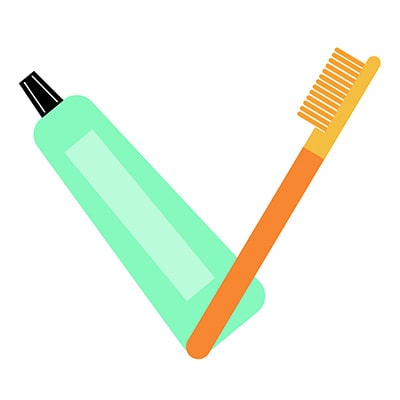Fluoride
Fluoride is known to be essential for maintaining good oral health.
So how can you benefit from all the advantages of fluoride, and where can you get it?

What are the uses of fluoride ?
The enamel is made of crystals, called carbonate substituted hydroxyapatite crystallites, which dissolve with a PH of 5.5. When the enamel contains fluoride we can observe fluorapatite crystals, which dissolve with a PH of 4.6 (more acid).
This means that fluoride-protected enamel dissolves less quickly in an acidic environment, as acidity is produced by bacteria growing in the mouth after each meal.
Fluoride reinforces the enamel of the teeth and helps to prevent tooth decay and cavities
Nevertheless, even if fluoride decreases the risk of caries, it cannot remove it entirely. It is essential to reduce the number of meals, sweet foods and have a correct tooth brushing technique.
Reminder: neutral PH is 7, the lower the PH, the more acid it is.
| Patient | Advised daily intake of fluoride mg per day |
|---|---|
| Children from 0 to 6 months | 0,1 mg |
| Children from 6 months to 1 year | 0,2 mg |
| Children from 1 to 3 years | 0,5 mg |
| Children from 4 to 8 years | 1 mg |
| Children from 9 to 13 years | 1,5 mg |
| Teenagers from 14 to 18 years | 2 mg |
| Women | 2 mg |
| Men | 2,5 mg |
| Pregnant or breast-feeding | 2 mg |
A.Martin et al. « Apports nutritionnels conseillés pour la population française » Ed Lavoisier, Tec&Doc.2001
Is fluoride dangerous?
In a normal use, fluoride is not dangerous; in the contrary it can be beneficial for your teeth.
Fluoride is naturally present in some foods and drinks:
- fish
- seafood
- tea
- certain minerals
We can swallow a small amount daily with no risks. Unfortunately, the floride swallowed will not protect adult patient’s teeth. It is only in children of which the tooth germ in still growing that the fluoride can integrate the enamel.

Where can I find fluoride to protect my teeth?
The source of fluoride such as tooth paste, mouth wash or gels and varnish are not swallowed. Their action is local and deposits itself on the surface of the teeth.
The protective layer containing fluoride is very thin (approx. 6 microns). Studies have shown the teeth get worn by 3 microns per day. Fluoride must be supplied regularly to obtain a continuous protection.
The easiest way to protect your teeth is to use a fluoride based tooth paste.
- Supermarket adult toothpaste contains between 1000 to 1500ppm (which is 1-1.5mg of fluoride per gram of toothpaste)
- In the chemist you can find toothpastes with up to 2500ppm of fluoride (which is 2.5mg of fluoride per g of toothpaste)

Does fluoride stain the teeth?
It was common practice some time ago to give fluoride drops or tablets to strengthen the teeth. In certain cases, white or brown marks appeared on the permanent teeth (fluorosis). These marks were due to an excess of fluoride swallowed during the formation of the teeth. This means that on top of the drops/tablets the children ingested originating from other sources (food, beverage, toothpaste…). The total quantity of ingested fluoride was over the recommended daily intake.
Today, the prescription of this medication is recommended only in certain specific cases. Usually, children do not receive fluoride drops anymore.
The updated recommendations are to use topical fluoride, which means using fluoride directly on the surface of the teeth, without swallowing it: toothpaste, dental varnish… the fluoride, not swallowed, is not absorbed in the tooth germ and only protects the teeth present in the mouth. This way is it impossible to create white or brown stains on the teeth.
Do you have discoloured teeth?
SCHEDULE AN APPOINTMENT
Fluoride and children
The very young children do not spit out all the toothpaste and swallow a small amount. This is why toothpaste for children contains a lower amount of fluoride than the ones for adults, which take into account the recommended daily intake. C’est aussi pour cela que les enfants qui ne savent pas encore bien cracher doivent utiliser des dentifrices adaptés à leur âge.
Only purchase toothpaste that is suitable for the age of your child. Use a very small quantity of toothpaste on the toothbrush for your child:
- Before the age of 3: the equivalent of a grain of rice once per day
- Between 3 to 6 years: the equivalent of a grain of rice twice per day
- After 6 years: the equivalent of a green pea 2 to 3 times per day
Be careful to the water that your child drinks. By mineral water that has low levels of minerals. The content of tap water is always available at the local town hall.








